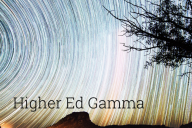You have /5 articles left.
Sign up for a free account or log in.
Self-help and self-improvement books aren’t simply for those seeking financial success or a more fulfilling love life. The genre now extends to those who want to improve their teaching.
The internet teems with articles that describe three steps, five ways, seven keys and 50 strategies to improve your teaching.
Much as the self-improvement literature can be boiled down to a few simple rules -- “take one step at a time,” “adjust your habits,” “alter your mind-set,” realize that “struggle is good” -- ditto for advice about teaching.
Here are some of the words of advice:
- Make your expectations clear
- Make eye contact and address students by name
- Supplement lectures with hands-on activities
- Recognize students’ accomplishments and respond appropriately to their concerns
- Draw connections between the course material and its real-world applications
There’s nothing wrong with those suggestions, but the advice is exceedingly abstract.
In recent years, attention to teaching has certainly grown and colleges have taken a variety of steps to try to improve its quality and effectiveness. Job candidates must submit a teaching philosophy. Student teaching evaluations are required. Teaching centers, teaching awards and teaching innovation showcases proliferate.
And yet, like so much of contemporary life, it’s hard not to see these as examples of Kabuki-like virtue signaling rather than systematic efforts to enhance teaching quality. Why? Because certain assumptions remain firmly intact.
- That teaching is an individual responsibility and each instructor is an individual artisan or solo practitioner whose ability to teach however they wish lies at the heart of academic freedom.
- That the classroom is a private space or black box that, except on the rarest of occasions, should not be subject to outside observation.
- That teaching itself is an intensely personal activity that is tied to an instructor’s persona, mannerisms and preferred modes of interpersonal interaction and is therefore not responsive to outside intervention.
- That effective teaching lies not in a body of knowledge and a set of practices and skills, but in performance attributes -- such as clarity, humor and passion -- that an instructor either has or hasn’t.
But perhaps the single biggest impediment to improvements in teaching lies in our recognition that all manner of college instructors can be effective, at least with some students.
I suspect we’ve all encountered a variety of teaching styles that work in some faculty members’ hands but not in others -- whether they resemble The Paper Chase’s officious Charles W. Kingsfield Jr., Animal House’s laid-back Dave Jennings or The Nutty Professor’s socially inept and insecure but nonetheless endearing Julius Kelp.
In other words, Tolstoy, in a wholly different context, had it wrong: it’s not the case that all effective instructors teach alike and that bad instruction takes many forms. In fact, any approach can be effective or ineffective.
Here are four pedagogical styles that can, depending on the professor, engage or repel students.
- The autocrat, who relies on direct instruction and Socratic questioning.
- The facilitator, who shifts the classroom’s focus from the teacher to the students themselves. Some facilitators favor discussion; others encourage whole-class or team-based inquiry and activities.
- The delegator, who cedes pride of place to the students, who are responsible for introducing class sessions, initiating and managing discussions, and making classroom presentations.
- The puppeteer, who prompts students to undertake various activities and follows up by helping students unpack the meaning of those educational experiences.
All that said, we do know that teaching and learning can be improved. But if quality and effectiveness are to be raised, then it is essential to recognize that teaching is part art, part craft and part science.
Teaching, like jazz, is an art that requires an ability to improvise. Imagination, inventiveness and inspiration -- qualities quite difficult to clone -- are attributes of some of the most impressive and memorable professors.
Teaching is also a craft, a set of skills that depends on expertise, practice, polish and attention to detail.
In addition, teaching is a science. Faculty members’ effectiveness can be enhanced if they attain a basic understanding of cognitive processes, intrinsic and extrinsic motivation, cognitive load, and short- and long-term memory; understand the value of generation effect, regulatory fit, mental modeling, metacognition, repeat testing and spaced practice; and how to apply principles derived from the science of learning in classroom settings.
Currently, our approach to improvement in teaching depends largely on inclination of individual faculty members, supplemented, in some instances, with financial incentives.
Faculty members decide individually whether to visit a teaching center -- even though we know that presentation skills, scaffolding and activity and assessment design can benefit significantly from formal training in evidence-based and theoretically informed practice.
So what would it take to truly improve teaching? Let me offer five suggestions.
- Initiate a systematic process of course redesign. Get teams of faculty to redesign the roughly 25 largest-enrollment courses with help from a team of teaching and learning experts, instructional designers, educational technologists, and assessment specialists.
- Incentivize departmental conversations. Incentivize departments to collectively reconsider their curriculum, pedagogy, learning outcomes, major requirements and rules about credit transfer.
- Give individual faculty members the support they need to innovative in their courses. Pair individual instructors or faculty teams with educational professionals, appropriate graduate students or talented undergraduates to enhance an existing class with technology and in other ways.
- Conduct an equity and outcomes audit of individual classes. Few of us are cognizant of any equity gaps in our classes or the number of students who withdraw or who fail. Nor are we aware of how our students do in subsequent courses. Now that such information is readily available, department chairs might meet with individual instructors and go over relevant data.
- Create a campus conversation about transformational teaching. Thanks to the Teagle Foundation, I was able, at Columbia, to create a campuswide collegium on psychological science and student learning that brought together leading cognitive and developmental psychologists and other learning and assessment specialists from Columbia, Teachers College and Barnard that transformed teaching and learning from a matter of presentation and communication skills into a translational research problem. As a consequence, it became clear that teaching wasn’t simply about knowledge transfer, cognitive development and skills acquisition and application, but was ultimately about development across multiple dimensions -- emotional, ethical and intra- and interpersonal, and involved executive functioning, memory, metacognition and much more. Research, at Columbia, is the coin of the realm, and as a research problem, teaching and learning received the attention they deserve.
At UT Austin, a massive investment in MOOCs paid off, but in unexpected ways. Leading faculty members, selected as part of a campuswide competition, received the resources -- financial, instructional and technological -- needed to create massive open online courses. The real impact, however, was indirect: not in the students they attracted, but in their own thinking about teaching.
These faculty members, with lots of scaffolding and support, experimented with new pedagogies, assessments and technologies, and became the campus’s foremost advocates for instructional innovation.
If there’s anything that I take away from those experiences, it is this: genuine improvements in pedagogy will only come when teaching is no longer seen simply as a matter of technique or performance or planning or even design, but rather as a matter of equity and the well-rounded development of our graduates.
Steven Mintz is professor of history at the University of Texas at Austin.



